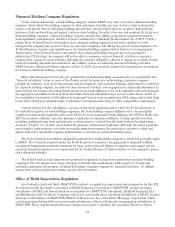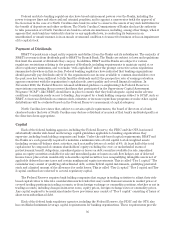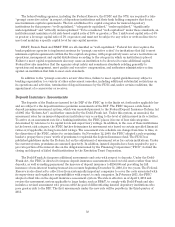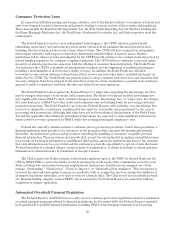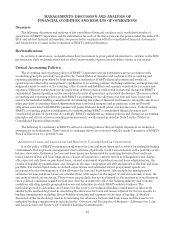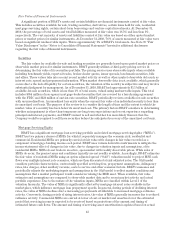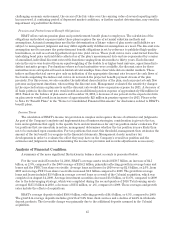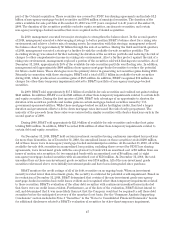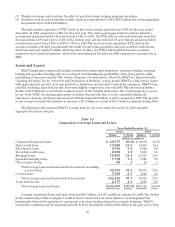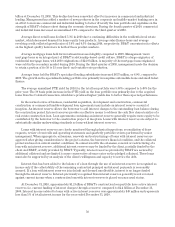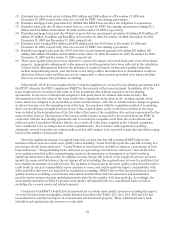BB&T 2010 Annual Report Download - page 44
Download and view the complete annual report
Please find page 44 of the 2010 BB&T annual report below. You can navigate through the pages in the report by either clicking on the pages listed below, or by using the keyword search tool below to find specific information within the annual report.
results and updated projections. In addition, BB&T has approximately $11 million of residential MSRs that are
valued at the lower of cost or market. These MSRs are associated with government sponsored programs that
have prepayment assumptions that are difficult to model, which make it difficult to hedge the associated risk.
Please refer to Note 8 “Loan Servicing” in the “Notes to Consolidated Financial Statements” for quantitative
disclosures reflecting the effect that changes in management’s assumptions would have on the fair value of MSRs.
Loans Held for Sale
BB&T originates certain mortgage loans to be sold to investors that are carried at fair value. The fair value
is primarily based on quoted market prices for securities backed by similar types of loans. Changes in the fair
value are recorded as a component of mortgage banking income while mortgage loan origination costs for loans
held for sale for which the Corporation elected the Fair Value Option are recognized in noninterest expense when
incurred. The changes in fair value of these assets are largely driven by changes in interest rates subsequent to
loan funding and changes in the fair value of servicing associated with the mortgage loan held for sale. BB&T uses
various derivative instruments to mitigate the economic effect of changes in fair value of the underlying loans.
In addition, as of December 31, 2010, BB&T held $521 million of nonaccrual commercial loans accounted for at
the lower of cost or market in the loans held for sale portfolio. These loans were originated as loans held for
investment and transferred to the loans held for sale portfolio based on management’s nonperforming asset
disposition strategy.
Derivative Assets and Liabilities
BB&T uses derivatives to manage various financial risks. The fair values of derivative financial instruments
are determined based on quoted market prices, dealer quotes and internal pricing models that are primarily
sensitive to market observable data. BB&T mitigates the credit risk by subjecting counterparties to credit
reviews and approvals similar to those used in making loans and other extensions of credit. In addition, certain
counterparties are required to provide collateral to BB&T when their unsecured loss positions exceed certain
negotiated limits. The fair value of interest rate lock commitments, which are related to mortgage loan
commitments, is based on quoted market prices adjusted for commitments that BB&T does not expect to fund
and includes the value attributable to the net servicing fee.
Venture Capital and Similar Investments
BB&T has venture capital and similar investments that are carried at fair value. Changes in the fair value of
these investments are recorded in other noninterest income each period. In many cases there are no observable
market values for these investments and therefore management must estimate the fair value based on a
comparison of the operating performance of the company to multiples in the marketplace for similar entities. This
analysis requires significant judgment and actual values in a sale could differ materially from those estimated. As
of December 31, 2010, BB&T had $266 million of venture capital investments, which is less than 1% of total assets.
Intangible Assets
BB&T’s mergers and acquisitions are accounted for using the acquisition method of accounting. Under the
acquisition method, BB&T is required to record the assets acquired, including identified intangible assets, and
liabilities assumed at their fair value, which often involves estimates based on third party valuations, such as
appraisals, or internal valuations based on discounted cash flow analyses or other valuation techniques, all of
which are inherently subjective. The amortization of identified intangible assets is based upon the estimated
economic benefits to be received, which is also subjective. Acquisitions typically result in goodwill, which is
subject to ongoing periodic impairment tests based on the fair value of net assets acquired compared to their
carrying value. Please refer to Note 1 “Summary of Significant Accounting Policies” in the “Notes to
Consolidated Financial Statements” for a description of BB&T’s impairment testing process. The major
assumptions used in the impairment testing process include the estimated future cash flows of each business unit
and discount rates. Discount rates are unique to each business unit and are based upon the cost of capital specific
to the industry in which the business unit operates. Management evaluated the sensitivity of the significant
assumptions in its impairment analysis including consideration of a 10% change in estimated future cash flows or
the discount rate for each reporting unit. After giving appropriate consideration to all available information,
management determined that no impairment of goodwill would have been incurred. However, as a result of the
44


